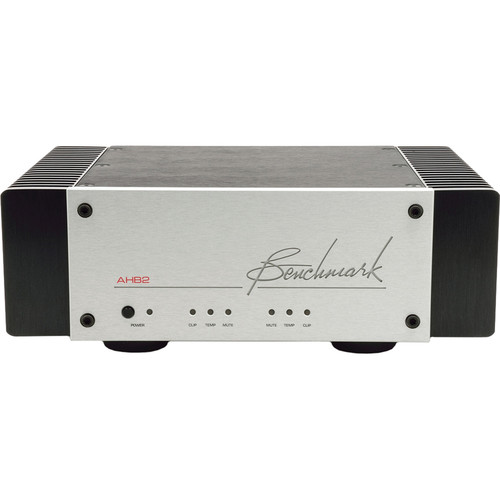

The Benchmark AHB2 uses a patented technology to eliminate most sources of distortion and increase dynamic range far beyond what was previously possible in high-end amplification systems. Chart 5B shows this to be similar in mono mode, but with the fifth harmonic being higher, and the seventh and higher harmonics visible but at extremely low levels.The Benchmark AHB2 is a high resolution power amplifier featuring a wealth of ground-breaking advances in design and performance. The magnitudes of AC line harmonics are relatively low, and the signal harmonics - consisting of the third and fifth harmonics in stereo mode - are extremely low in amplitude. Spectra of the THD+N residue of a 10W, 1kHz test signal are plotted in Charts 5A and 5B. frequency (Chart 4) is of a value and nature typical of many solid-state amplifiers: high up to 1-2kHz, then rolling off with increasing frequency. The plot of the AHB2’s damping factor vs.

High-frequency THD+N is admirably low, and in stereo and mono modes, the AHB2’s level of distortion throughout most of the power range is amazingly low. The AHB2’s THD+N as a function of frequency at different power levels is plotted in Chart 3. Chart 2B shows the mono results into 8 ohms in bridged mono, the AHB2 is not rated for use into a load of 4 ohms. power varied with 1kHz and SMPTE intermodulation test signals and amplifier output load into loads of 8 and 4 ohms.
BENCHMARK AHB2 PLUS
Because the AHB2’s output regulation is so good, its measured performance into the IHF dummy load showed no significant variation within the audioband.Ĭhart 2A illustrates how the AHB2’s total harmonic distortion plus noise (THD+N) vs. The slightly greater high-frequency rolloff in bridged-mono mode (not shown) is due to the series-connected nature of that mode, which caused the HF deviation with load to show up more than in stereo mode. Most of the testing was done at the 2V sensitivity the distortion results were pretty much the same at the 9.8V sensitivity.Ĭhart 1 shows the AHB2’s frequency response into different loads. The AHB2 has input sensitivities of 2V, 4V, and 9.8V. I must say that they’ve succeeded I measured less distortion and noise in the AHB2 than in any other of the many power amps I’ve measured over the years.īecause the AHB2 can be switched between stereo and bridged-mono modes, some measurements were taken with the amp in both modes the charts labeled “B” indicate measurements in bridged mode. The AHB2 is Benchmark’s attempt to produce a very-low-distortion, low-noise power amplifier using THX’s AAA Technology, which linearizes the amp’s class-AB output stage without using large amounts of overall negative feedback. Output noise 9.8V sensitivity (stereo mode), 8-ohm load, balanced inputs terminated with 600 ohms, Lch/Rch.Output noise 4V sensitivity (stereo mode), 8-ohm load, balanced inputs terminated with 600 ohms, Lch/Rch.Output noise 2V sensitivity (stereo mode), 8-ohm load, balanced inputs terminated with 600 ohms, Lch/Rch.Input impedance 1kHz, stereo and mono: 47.0k ohms.Input sensitivity for 1W output into 8 ohms (mono).Input sensitivity for 1W output into 8 ohms (stereo).Gain (mono), output voltage divided by input voltage, 8-ohm load.Gain (stereo): output voltage divided by input voltage, 8-ohm load.Power output at 10% THD+N: 450.0W 8 ohms.Power output at 1% THD+N: 403.6W 8 ohms.Unless otherwise noted, the data reported below are for the left channel. Notes: Measurements of the Benchmark AHB2 were taken at the balanced inputs of both channels at 120V AC line voltage, both channels driven. Reproduction in any format is not permitted. All measurement data and graphical information displayed below are the property of the SoundStage! Network and Schneider Publishing Inc. All amplifier measurements are performed independently by BHK Labs.


 0 kommentar(er)
0 kommentar(er)
